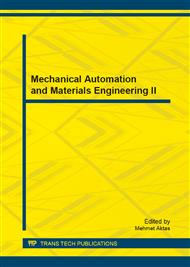p.26
p.32
p.36
p.41
p.45
p.49
p.57
p.62
p.71
The Modulation Study of Emulsified Heavy Oil from Liquid Waste after Pyrolysis of Waste Rubber
Abstract:
The present research was involved in forming Modulation, Atomizing temperature, adding proportion etc. In addition to ameliorate heat value and Combustion stability of the Emulsified heavy oil modulated from liquid waste after the waste rubber pyrolysis in resource chemical plant. Solve waste rubbers pyrolysis process liquid wastes generated problems This study explored optimal condition of Emulsified heavy oil modulation based on relevant tests to enhance its heat value and combustion stability for optimal utilization of emulsified fuel. The results can serve as a reference to the Emulsified heavy oil modulation process design and mixing with liquids waste. The main component of the formula is an emulsion, Surfactant as emulsion to make the fuel oil uniformly mix with liquid waste. Besides finding a suitable formula, this study also conducted analysis on product property and developed technique to improve process and product property, as an important reference for future studies.
Info:
Periodical:
Pages:
45-48
Citation:
Online since:
June 2014
Authors:
Keywords:
Price:
Сopyright:
© 2014 Trans Tech Publications Ltd. All Rights Reserved
Share:
Citation:


